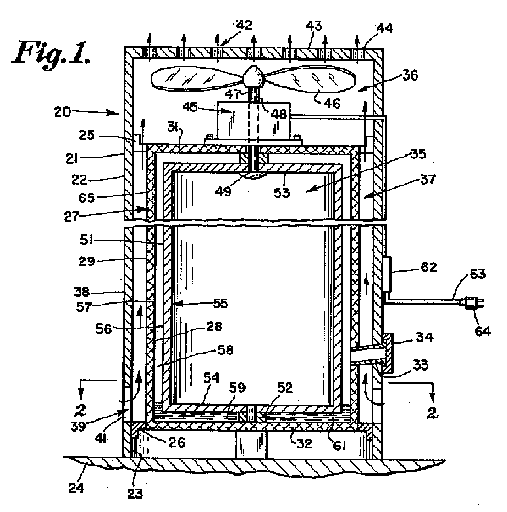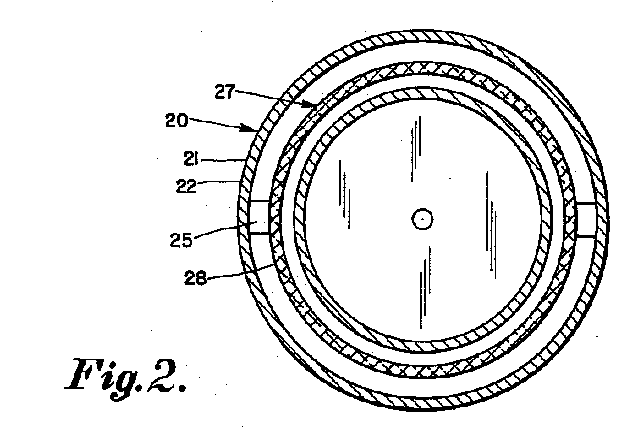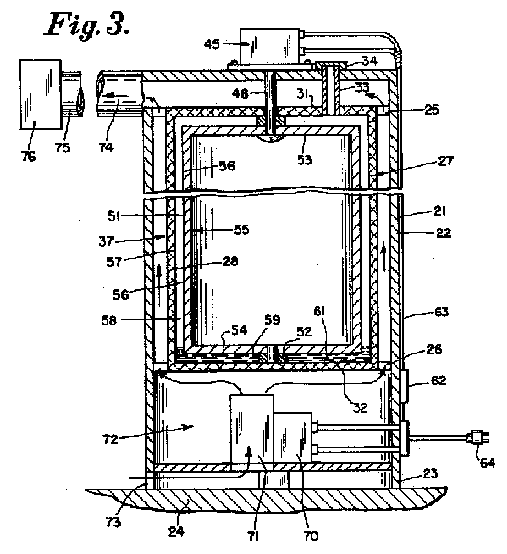
| Frenette | US Patent # 4143639 | Mechanical Heater |
Other fuelless friction heater info here
Friction heat space heater
Abstract
A furnace or space heater is operable at low cost by a small electric motor which rotates an elongated cylindrical drum on a vertical axis, within an elongated cylindrical casing at a clearance of about one eighth of an inch in the annular chamber formed therebetween. A supply of light lubricant normally occupies the lower portion of the annular chamber but rises to fill the chamber during rotation of the drum. The casing is enclosed in a housing, having a fan chamber containing an electric motor and fan or blower. The motor shaft may rotate both the fan and the drum.
SUMMARY OF THE INVENTION
Unlike the above mentioned patents wherein thin discs or vanes, in single or
stack configuration, comprise the rotor, in this invention an elongated,
cylindrical smooth surfaced, inner drum is the rotor. The drum is rotated in a
horizontal plane on a vertical axis within an elongated cylindrical, smooth
surfaced casing, or outer drum, to form an annular sealed, liquid, chamber
therebetween having a clearance of about one eighth of an inch. A quart of
relatively light oil is captive in the annular chamber and at rest occupies only
the bottom thereof. However upon rotation of the drum, by an electric motor of
about one horse power, the oil rises to fill the chamber due to the pumping
action of the drum.
Thus friction heat is generated not by two metal, or other, surfaces contacting
each other, but by the contact of the opposing surfaces with the oil which not
only lubricates but generates heat.
A portable space heater is formed by enclosing the casing and drum in the lower
chamber of a housing and drawing ambient air inwardly and around the heated
outer surface of the casing for fan discharge back into the ambient atmosphere
by a large diameter, eight bladed fan driven by the drum motor, or preferably by
a separate motor. For use as a furnace an air blower and separate electric motor
blow ambient air around the casing for discharge into a heating system.
BRIEF DESCRIPTION OF THE DRAWING
FIG. 1 is a front elevational view of the portable space heater of the
invention, in half section;
FIG. 2 is a top plan view in section on line 2--2 of FIG. 1; and
FIG. 3 is a view similar to FIG. 1 of the device of the invention in its
preferred form.
DESCRIPTION OF A PREFERRED EMBODIMENT
FIGS. 1 and 2 illustrate one embodiment of the friction heat heater 20 of the
invention which includes an upstanding, hollow, cylindrical housing 21 formed of
imperforate sheet metal 22 and having legs 23 for supporting it on a floor 24 of
a building. The space heater 20 is portable and in the portable embodiment
illustrated in FIGS. 1 and 2 the housing 21 is of predetermined diameter of
about twelve inches and of predetermined height of about thirty-two inches.
Fixed within housing 21 by suitable brackets 25 and 26 is a hollow cylindrical
casing, or outer drum, 27 which is of predetermined diameter less than the
diameter of the housing, such as ten inches, and is formed of aluminum sheeting
28 for efficient transfer of heat. The cylindrical side wall 29, top wall 31 and
bottom wall 32 of casing 27 are imperforate to form a sealed enclosure except
for the filler tube 33, which is closed by a removable threaded cap 34.
The casing 27 divides housing 21 into the lower air heating chamber 35, which it
occupies and an upper fan chamber 36, there being an annular air chamber 37
formed between the cylindrical side wall 29 of the casing and the coaxial,
concentric cylindrical side wall 38 of the housing 21.
Air inlet means 39 is provided in the lower portion of the housing 21 in the
form of spaced apertures 41 extending around the cylindrical side wall 38 and
air outlet means 42 is provided in the top 43 of the housing in the form of
apertures 44. The annular air chamber 37 connects the air inlet means to the air
outlet means of the fan chamber 36.
A reversible electric motor 45 is mounted in the fan chamber 36 with an eight
bladed fan 46 fast on one end 47 of the motor shaft 48, each blade being of
about 25.degree. pitch and the motor being about one horse power for rotating
the shaft 48 at between 1800-3600 R.P.M.
The other end 49 of motor shaft 48 extends into the air heating chamber 35 to
rotate the hollow, cylindrical drum 51 which is supported in suitable bearings
52 for rotating around the central, vertical axis of the casing 27 and housing
21.
The inner drum 51 is sealed and hollow and includes the top wall 53, bottom wall
54 and cylindrical side wall 55, the walls being of stainless steel. The
exterior cylindrical surface 56 of the cylindrical side wall 55 is smooth as is
the interior, cylindrical surface 57 of the aluminum of the cylindrical side
wall 29 of casing 27 and the surfaces 56 and 57 are at about one eight inch
clearance from each other to form a narrow, annular liquid receptacle 58
therebetween.
It should be noted that the annular liquid receptacle 58 is not a passage
through which liquid to be heated is continually flowed, as in the above
mentioned prior art patents. Instead it is a sealed chamber and is provided with
a supply of liquid lubricant 59 such as a quart of No. 10 oil which normally
rests in the horizontal space, or shallow liquid receptacle 61 between the
bottom wall 54 of the drum 51 and the bottom wall 32 of the casing 27.
It has been found that the best results are obtained when the lubricant 59 is
Quaker State F-L-M-A-T Fluid, Ford Motor Company Qualifications No. 2P-670306 M
2633F. Unlike prior patents, no water is in contact with the oil.
The motor 45 is connected to a thermostat 62, of any well known type by cord 63
and to a source of electricity by male plug 64 so that it is energized under the
control of ambient temperature by the signals of the thermostat.
In operation the motor 45 drives the drum 51 at a substantial speed, which
causes the oil 59 to rise up into the annular liqud receptacle 58 to
substantially fill the same. The heat of friction between the inner drum 51 and
outer drum, or casing 27 is transferred by the oil while it prevents wear on the
surfaces 56 and 57 so that the exterior aluminum surface 65 of the fixed outer
drum 27 becomes heated. Meanwhile the large diameter, multibladed fan 46 is
drawing ambient air through the air inlet means 39, thence up through the
annular air chamber 37 and past the elongated heated surface 65 for discharge
through the air outlet means 42 back into the room.
As shown in FIG. 3, it is preferable to provide a separate electric motor 70,
usually about 1/8 H.P. and driving an air blower 71, these being mounted in a
lower air chamber 72 for driving ambient air upwardly in an annular flow path in
chamber 37 from the air inlet means 73 to the air outlet means 74. Air outlet
means is the intake duct 75 of a hot air heating system 76 so that the heater 20
becomes a furnace rather than a space heater, the separate electric motor 70
enables the thermostat 62 to initiate rotation of the drum until a predetermined
temperature is reached in the aluminum outer drum 27, whereupon the thermostat
automatically de-energizes the drum motor 45 while continuing to rotate the
separate fan, or flower motor such as 70, to furnish hot air to the room or
heating system 76 until the casing 27 cools to a predetermined temperature.


